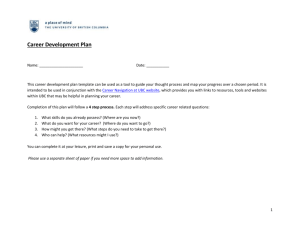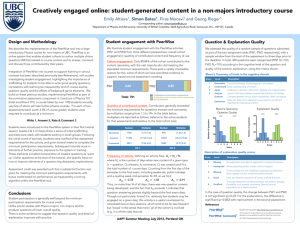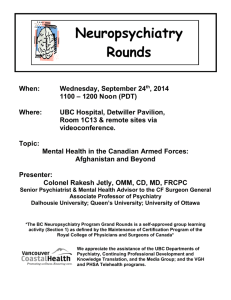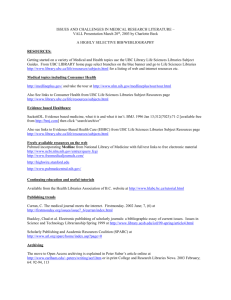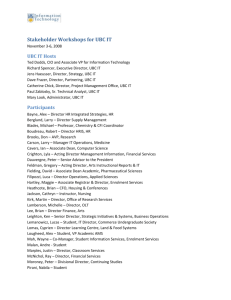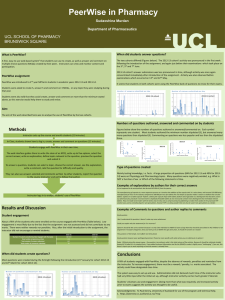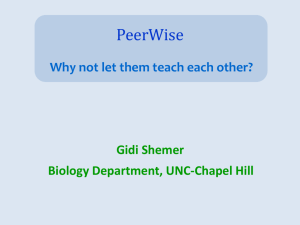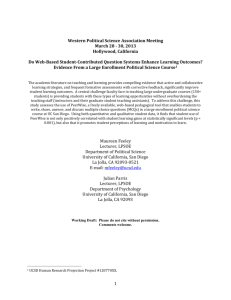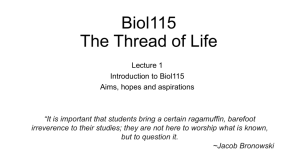Students' Projects in Large Introductory Physics Courses at Ryerson
advertisement
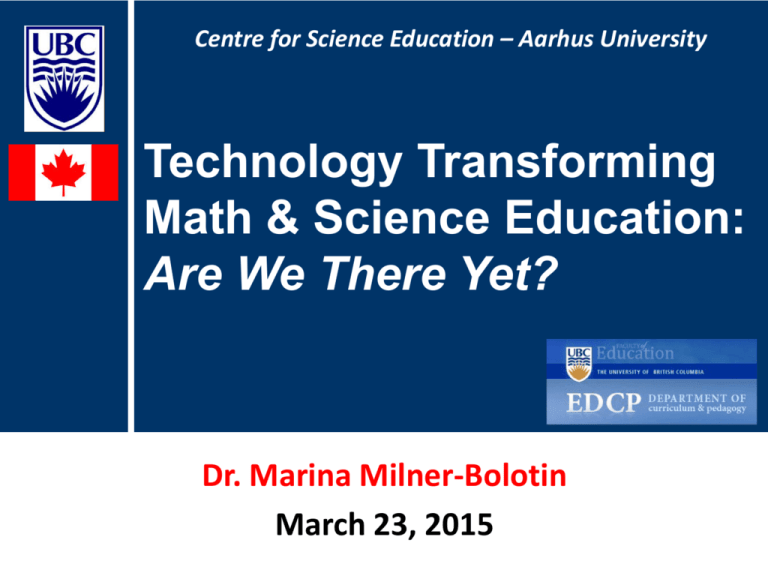
Centre for Science Education – Aarhus University Technology Transforming Math & Science Education: Are We There Yet? Dr. Marina Milner-Bolotin March 23, 2015 Acknowledgements UBC TLEF support 2012-2015 2 Does technology presence guarantee improved student learning? 3 Dr. Marina Milner-Bolotin • Assistant Professor in Science Education, UBC, Canada • Department of Curriculum & Pedagogy • e-mail: marina.milner-bolotin@ubc.ca • Web site: http://blogs.ubc.ca/mmilner/ 4 My Science Education Trajectory V-scope 5 Our Science Education Trajectory From world renowned “schools of physics” led by Bohr, Landau, etc. to the mass production of students in large courses… 6 6 Science Education in Canada Science Exposure K-12 Elem Second University B. Science Other fields 7 Teacher Education in Canada Bachelor Subject + B.Ed. Elem. B.A. B.Ed. Secondary B.Sc. B.Ed. 8 Teacher Education in Canada 9 Gates’ Foundation 2015 Report (January 2015) This framework identifies two distinct segments that account for over 40% of the faculty and are well poised to be adopters of techniques, tools, and behaviors which will benefit students. Of this entire group, half are already adopting some emerging practices, and may serve as exemplars to others. (p. 5) [FTI Consulting. (2015). U.S. Postsecondary Faculty in 2015: Diversity in people, goals and methods, but focused on students: FTI Consulting.] 10 Our Research on Technology Use in Science Education 1. Peer Instruction (clickers) 2. Collaborative student work (PeerWise) 3. Live Data collection and analysis (Logger Pro) 4. Computer simulations (PhET) 11 I. Peer Instruction Electronic response systems (clickers) in science classrooms… Peer Instruction PI: Challenging Assumptions Answers given by pre-service physics teachers Peer Instruction Example Peer Instruction in Action Pre-Discussion Poll 4 2 0 Post-Disc. Poll 4 1 Respondents: Physics Teacher-Candidates 1 0 Math & Science Teaching & Learning through Technology Navigating the Resource Navigating the Resource http://scienceres-edcp-educ.sites.olt.ubc.ca/ Question Titlea Pulley Blocks and Two blocks are connected via a pulley. The blocks are initially at rest as block m1 is attached to a wall. If string A breaks, what will the accelerations of the blocks be? (Assume friction is very small and strings don’t stretch) A m1 A. = a1 0;= a2 0 B B. = a1 g= ; a2 g C. = a1 0;= a2 g m2 D. = a1 g= ; a2 0 E. None of the above Why are the assumptions above important? Comments Solution Answer: E Justification: None of the above answers is correct. Consider two blocks as one system: one can see that the system has a mass of (m1+m2), while the net force pulling the system down is m1g. Therefore, applying Newton’s second law, one can see that the acceleration of the system must be less than g: = a m2 g = ( m1 + m2 ) m2 g<g ( m1 + m2 ) Some people think that the acceleration will be g. They forget that the system consists of two blocks (not just m1) and the only pulling force is m1g. Thus the system is NOT in a free fall. Compare this questions to the previous one to see the difference. II. PeerWise Online System http://peerwise.cs.auckland.ac.nz/ Technology-Enhanced Active Engagement Integration Peer Instruction modeled in every class PeerWise used to design, critique, respond to Conceptual Questions as a community of future teachers PeerWise Pedagogy [Res. & Pract. in Math, Sci. & Techn. Ed., 2013. 1(5): p. 525-544.] [Physics in Canada., 2014, 70(3): p. 149-150] III: Live Data Collection & Analysis 2007, Journal of College Science Teaching, 36(4), 45-49. 2008, The Physics Teacher, 46(8), 494-500. Example: Demos vs. Interactive Lecture Experim’s Only 25% of the students chose the correct response. 59% chose the incorrect response (D). [ M. Milner-Bolotin et al, Journal of College Science Teaching, March 24, 2015 CAP Congress Saskatoon 2007 January-February 2007, pp.45-49.] 26 Pedagogy: Interactive Lecture Experiment Students work in small groups, collect necessary data, come up with the analysis and solution and then check if their answer is meaningful using in-class live experiment (data collection). Traditional lecture demonstrations are replaced by Interactive Lecture Experiments March 24, 2015 27 Post-Instruction Results March March 24, 2015 24, 2015 CAP Congress Saskatoon 2007 28 28 Making Science Relevant Why do you sometimes feel lighter and sometimes heavier in an elevator? A water jar was placed on a force plate inside a moving elevator: weight and apparent weight problem March March 24, 2015 24, 2015 29 IV: Computer Simulations Developing Science Intuition Simulations help develop physics intuition via testing experimentally different scenarios – WHAT IF…? (Think critical thinking). T = 2π March 24, 2015 l g We can place the pendulum on Moon, Earth, Jupiter or even Planet X… 31 Conclusions: Deliberate Pedagogical Thinking with Technology Technology opens unprecedented opportunities for educators, but we have just scratched the surface. We have to explore how to use it to promote meaningful science education. Teacher education both at K-12 and post-secondary levels should model effective research-based uses of technology. UBC Science Teacher Education 34



